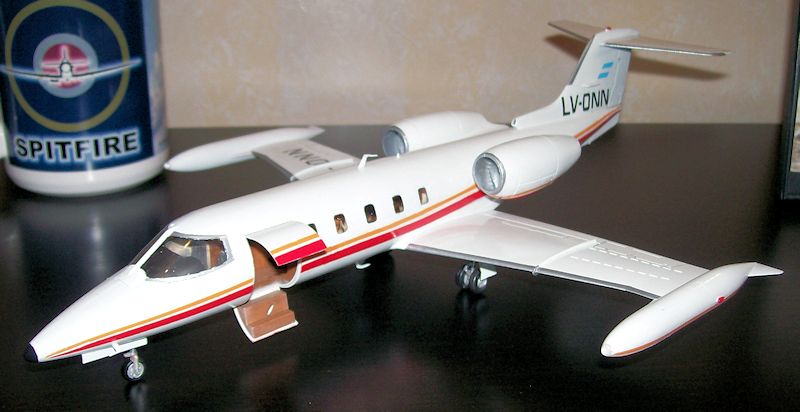
| KIT #: | 436 |
| PRICE: | $ |
| DECALS: | Two options |
| REVIEWER: | Pablo Calcaterra |
| NOTES: |
Built
as flown during the South Atlantic War in 1982 |

| HISTORY |
When the conflict in the South
Atlantic for the Beagle Channel islands between Argentina and Chile seemed to
inevitably be leading to war in 1978 former Argentine Air Force Brigadier Mayor
Hidalgo Oliva approached the Air Force’s authorities with an innovative plan: to
use civilian aircraft to harass the Chilean rear lines.
The plan was approved and the
feasibility to attach machine guns and bombs to these planes was studied.
Several items were
requested from the Air Force and these included uniforms, gunsights, survival
kits, armament. Tests were carried out successfully. It is estimated that
should there had been a war the Air Force would have increased the available
assets with an additional 140 (light) planes (i.e. Piper Azteca and Beechcraft).
It was decided, after an exhaustive evaluation, that planes might be armed (with
one machine gun and 2 bombs.
The scope of missions to be undertaken could have been (this is only
theorical): Search and
destruction of enemy soft skinned vehicles behind enemy lines, attack to enemy
planes if they were in lightly defended airfields, transport and SAR. The hard
points to be added under the fuselage of these civilan planes was designed by
Paez Allende and a prototype was built at Dammontti Hnos company in Don Torcuato.
During the final days of December
1978 the situation was defused when both Governments accepted the mediation of
the Vatican. Even so it was decided to proceed with the evaluation of the
mechanism to drop bombs and a successful test was carried out on Jan 4th 1979
when a 100 kg bomb was dropped from a PA 23 Aztec (LV-JGL).
After this the project was shelved
and their members returned to their normal life and occupations.
The idea is reborn:
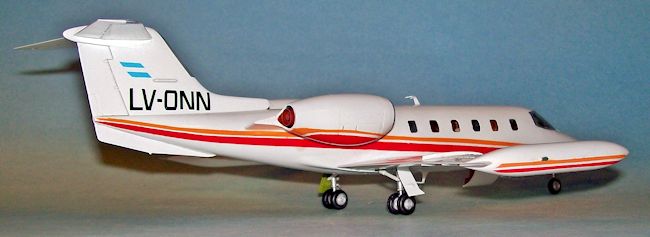 On April 2nd 1982 and after
learning about the successful Argentine operation to retake the Malvinas
(Falklands) Islands Retired Air Force Captain Paez Allende requested permission
not to travel to the US where he was going to undergo a session of training as
pilot of Austral Lineas Aereas (one of the two civilian airlines). Ten days
later he and many others were called back into active service. His task was to
work on projects that would have extraordinary aims and tools. As part of the
team several Air Force officers joined his team. Among them Mj Juan Jose
Falconier and Capt Hector Ritondale. The new Squadron would carry out
non-operational tasks such as transportation of personnel, support to Air units,
transport of spare parts and others. Taking into account that the performance of
the planes and experience of civilian and military aircrews assigned to Fenix
the Commander of Air Force South decided to expand the type of missions to be
flown including now non armed offensive ones (patrol and visual and radar
reconnaissance, enticing British CAPs to move them away from the true fighter
bombers path, guide of combat planes to target area to name a few). By April
23rd the plan had been designed. It included the following actions:
On April 2nd 1982 and after
learning about the successful Argentine operation to retake the Malvinas
(Falklands) Islands Retired Air Force Captain Paez Allende requested permission
not to travel to the US where he was going to undergo a session of training as
pilot of Austral Lineas Aereas (one of the two civilian airlines). Ten days
later he and many others were called back into active service. His task was to
work on projects that would have extraordinary aims and tools. As part of the
team several Air Force officers joined his team. Among them Mj Juan Jose
Falconier and Capt Hector Ritondale. The new Squadron would carry out
non-operational tasks such as transportation of personnel, support to Air units,
transport of spare parts and others. Taking into account that the performance of
the planes and experience of civilian and military aircrews assigned to Fenix
the Commander of Air Force South decided to expand the type of missions to be
flown including now non armed offensive ones (patrol and visual and radar
reconnaissance, enticing British CAPs to move them away from the true fighter
bombers path, guide of combat planes to target area to name a few). By April
23rd the plan had been designed. It included the following actions:
It is interesting to mention that
among the serving members there were Jimmy Harvey and “Tito” Withington,
Argentine volunteers who flew with the RAF as pilots during WWII.
Most relevant actions of the Fenix
Squadron:
May 1st: VERSO: a M2/60 flew in SAR
mission
PUA: a diversion mission when
during the morning two HS125 pretended to be Argentine fighters and flew close
to San Carlos Sound.
Other missions flown included
Retransmission of communications in the air and more diversion and exploration.
In total 9 sorties were carried out
by Fenix.
OF S/Nº: LR-35A LV-ONN, (RÓTULO).
Mission: patrol and reconnaissance. Crew: alféreces Jorge Mac Intyre and Arnoldo
E. López. From Naval Base Comandante Espora. Take off 11.55; landed 14.28.
May 2nd: Several missions to look
for the enemy were flown by the C-500s, LR-35s and even F-27s from the Air
Force. One of those missions, flown by LR-35s and called SANTO was similar to
the one the day before when the planes flew and great height close to the
islands and then dove to the surface of the sea returning out of sight of the
British radars.
May 3rd: Nine more missions were
flown this day and were intended to attract the British CAPs, feint attacks,
search for the enemy and retransmit communications.
OF 1136: LR-35A LV-ONN,
(LINCE).
Mission: patrol and reconnaissance with radar.
Crew: captain Narciso Juri, Lt. Enrique G. Felice y 1st corporal o Alejandro
López. Left Comodoro Rivadavia at 13.25; flew to 53º30’S/54º00’W (southeast of
the islands); returned 17.05.
May 4th: 3 missions were flown by
LR-35 and C-500 including one that arriver over the islands at 11:00 am
May 5th: the squadron flew another
11 missions looking for the enemy without success. These included both Air Force
(such as LR-35 T-22) and civilian planes (C-500 and LR-35s)
May 6th: two OF (2020/1 and /2)
were flown to support the flights of C-130s that transported items to the
islands. During these missions both LR-35 LV-OFV and T-22 flew at different
heights and changed directions several times in order to confuse the British
eyes. Three more missions to look for the British Task Force were flown by more
LR-35s and some by F-27 (from the Air Force)
May 7th: One Electra from the
Argentine Navy saw 5 warships 80 miles away from Isla de los Estados. So two
LR-35s here sent to confirm the sighting. LR-35 Leon 1 with Mj Gonazlez, Capt.
Ceaglio took off from Rio Grande in Tierra del Fuego and found those 5 warships
sailing south. In order to avoid being
 potentially shot down by missiles the
Lear dove to the surface of the sea and flew back to their base. A mission to be
flown to attack these targets was not carried out by the Super Etendards…
potentially shot down by missiles the
Lear dove to the surface of the sea and flew back to their base. A mission to be
flown to attack these targets was not carried out by the Super Etendards…
In the evening and into the night
two more missions were flown by LR-35 in search of those mystery ships but
without success.
Three more missions were flown by C-200 and
LR-35 in search of enemy ships in the waters close to the continent.
May 8th: The Air Force was trying
to force the Sea Harriers to take off from their carries in order to give away
their position. Thus a mission with an Argentine CAP (two IAI Daggers) flew
close to the islands and succeeded in enticing on of the Sea Harrier CAPs. Their
mission accomplished and with several technical problems the Daggers returned to
their base. A follow up was carried out, this time by Fenix Squadron. Sections
and individual flights of LR-35 arrived over the islands but they were not
successful in provoking a British reaction. In total 7 Learjets took part in
these missions.
Almost ten more missions to look
for the enemy ships were carried out this day.
May 9th: During the early hours the
British Task Force units to shell the Argentine positions around the capital.
The Argentine Air Force used a new ruse: Two LR-35 tok off from Comodoro
Rivadavia at 1:26 and upon arriving over the islands started to fly using a
profile that would replicate those used by warplanes. They were even able to see
the flashes of the British guns and the explosions on the ground. Ten minutes
after they arrived over the islands (02:36) the British ships stopped their
attack and turned back. At the same time a British CAP took off to engage the
Argentine “warplanes” but they were not able to get close to the Learjets that
escaped without further incident.
Later in the morning two ships were
detected close to the north of the islands and the Argentines decided to strike.
In order to have more precise information two OF (2047/9) were issued for LR-35
to look for these ships. The first one was chased by a CAP of Harriers for 30
miles after they had arrived over Puerto Argentino (Stanley). The second section
and flying at angels 350 made contact with the radar operator in the islands. At
that moment (10:30) PEPE 2 informed of a missile approaching. Both Lears broke
formation and a couple of (Sea Darts) were seen flying almost horizontally.
Without further ado the Lears returned home.
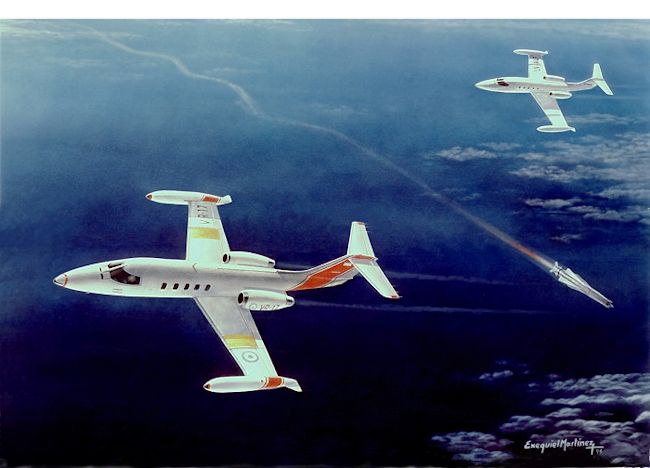 Yet another section of Learjets
(LITRO) flew to the islands looking for the enemy ships. The first plane had to
abort due to mechanical problems but the second one (Capt. Arques, Lt Cercedo
and Lt Dominguez) arrived over Puerto Argentino (Stanley) and then they flew
north. The radar told them to turn as fast as possible. They started to turn
right and the radar operator told them to tighten and speed up their turn (as
much as possible). At that moment 1st Lt Dominguez saw a Sea Dart flying past
the tip of one of the wings. The Lear dove to the surface and returned without
harm to Rio Gallegos.
Yet another section of Learjets
(LITRO) flew to the islands looking for the enemy ships. The first plane had to
abort due to mechanical problems but the second one (Capt. Arques, Lt Cercedo
and Lt Dominguez) arrived over Puerto Argentino (Stanley) and then they flew
north. The radar told them to turn as fast as possible. They started to turn
right and the radar operator told them to tighten and speed up their turn (as
much as possible). At that moment 1st Lt Dominguez saw a Sea Dart flying past
the tip of one of the wings. The Lear dove to the surface and returned without
harm to Rio Gallegos.
Aboard HMS Coventry it was
thought that these had been C-130 missions to reinforce the Argentines and that
they had been successful in preventing them from reaching Puerto Argentino
(Stanley) but in fact it had been Learjets who had dodged the missiles. As the
echoes of the missiles and the plane had seen to converge and the plane lost
attitude HMS Broadsword assumed that the Sea Dart had in fact shot down a plane.
When this was denied then HMS Coventry claimed that they had shot down the 2
A4-C lost in this day by the Argentines. For more about HMS Coventry and these
missions read
http://modelingmadness.com/review/misc/ships/gb/calcov.htm
Finally a 4th section (PICO)
managed the lure some Harriers and made them chase them away from the islands
for 30 miles. Clearly this added to the frustration of the Sea Harrier pilots as
they believed that the Argentine “fighters” did not want to play ball when in
fact they were being diverted away from the path that the real fighter bombers
were going to use.
Besides these exciting missions
there were 8 more flown looking for the enemy Task Force in other areas.
OF S/Nº: two LR-35A, (PACO),
T-22 and
LV-ONN. Crew: mayor Roberto F. Cardoso and captain Narciso
Juri. Took off from Comodoro Rivadavia, landed in San Julián;
over the islands at 2.05 and returned at 3.59.
May 10th: more search missions were
flown without incident
May 11th: besides the now routine
search missions the Argentine Air Force devised an operation to try to lure the
Sea Harriers and at the same time detect the plane carriers. In this case a
KC-13 (NATO flown by Mj Briend and crew) flew close to the islands and
“refuelled” two Argentine fighter bombers. These were in fact two LR-35 (OF2058)
called CONDE 1 and 2. The leader was LVO-ONN and was crewed by Capt. Buira, Capt
Pane and 1st Cpl Rocha. The 2 Lears formatted on the KC-130 and simulated
being refuelled. The trick did not work and no British CAPs or ships were
detected.
May 12th: 11 missions were flown by
the Learjets as they tried to look for the enemy and feint attacks to distract
the British Sea Harriers. At the same time and at much lower height the A4-Bs
succeeded in leaving out of combat HMS Glasgow with a bomb that perforated the
hull from side to side (but at a high price as 50% of the Skyhawks were lost).
Another member of the Fenix Squadron was used to retransmit and control the
attack planes. It was HS125 (RAYO) and was flown by Lt Poggi, NCO Acosta, Vice
Cdr Torres and Mj Medina). This turned out to be the last daylight mission to
shell the Argentine positions around Puerto Argentino (Stanley) as the cost
became too high.
OF 2066: two LR-35A (FUEGO)
Mission: patrol and visual reconnaissance. Crew LV-ONN: captains Carlos A. Pane
and Antonio F. Buira, and 1st corporal Dardo C. Rocha. Crew T-24: 1st
Lt. Eduardo
E. Bianco and Lt. Luis A. Herrera. Left Río Grande at 7.45 flying over the
islands and returning 9.45.
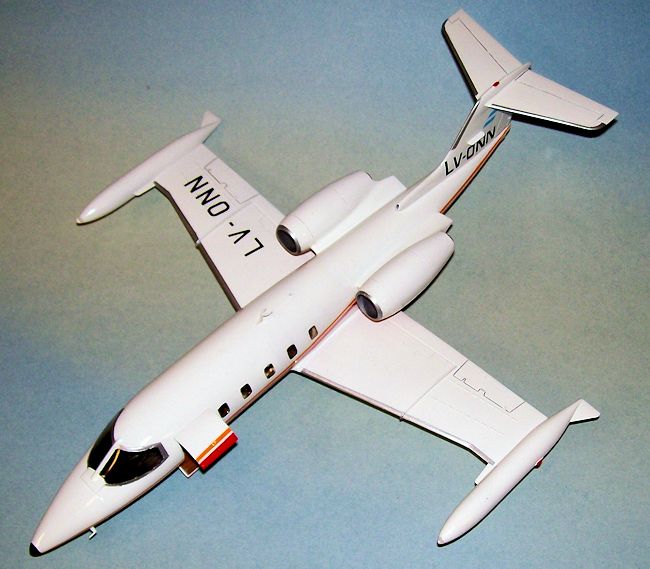 OF 2067: LR-35A LV-ONN (NÁCAR)
Mission:
patrol and reconnaissance. Crew: captain Antonio F. Buira, Lt. Luis A. Herrera
and 1st corporal o Dardo C. Rocha. Left Río Grande at 16.10; returned 17.50.
OF 2067: LR-35A LV-ONN (NÁCAR)
Mission:
patrol and reconnaissance. Crew: captain Antonio F. Buira, Lt. Luis A. Herrera
and 1st corporal o Dardo C. Rocha. Left Río Grande at 16.10; returned 17.50.
May 13th: several missions were
flown to look for enemy targets over the sea. LR-25 LV-OEL (CASERO 5) found high
seas fishing vessel Narwal.
May 14th: many more missions in
search of the enemy were flown but to no avail.
OF 2091: LR-35A LV-ONN,
(LIBRA)
Mission: patrol and visual reconnaissance. Crew: captain Juan
M. Martínez Villada, Lt. Luis A. Herrera and 1st corporal o Dardo C. Rocha. Left
Río Grande 10.35; landed at Comodoro
Rivadavia at 13.35.
May 15th: Thirteen missions were
flown by Fenix.
After the SAS attack on Borbon
(Pebble) Is. the Air Force sent 4 more IA-58 to the islands. These were led by
Mitsubishi LV-ODZ (this was repeated 3 more times during the last days of May)
OF 2103:
LR-35A LV ONN
(BOMBO).
Mission: patrol and
visual reconnaissance visual plus diversion. Crew: Juan M. Martínez Villada, Lt.
Luis A. Herrera and 1st corporal Dardo C. Rocha. Left Río Grande at 12.50; flew
close to Malvinas, and returned at 15.35.
May 16th: as follow up of one of
the missions flown on the 15th a Learjet was used in a 5 hour mission to fly
above and close to the islands in order to calibrate the radar of Puerto
Argentino. More than 5 missions looked for potential targets without success.
May 17th: Lear T-24 was used to
look for enemy radar emissions. Other flights took place in search for the Task
Force (F-27, B-707, TS-60).
May 18th: at least 10 more missions
in search of the enemy were flown
OF 2118: LR-35A LV-ONN
(POMO).
Mission: patrol and reconnaissance visual. Crew: captain Juan
M. Martínez Villada, Lt. Luis A. Herrera and 1st corporal Dardo C. Rocha. Left
Río Grande at 13.50; returned at 16.25.
May 19th: more missions flown
without finding the enemy
OF 2124: LR-35A LV-ONN (MALO).
Mission: diversión, patrol and visual reconnaissance. Crew: captain
Juan M.
Martínez Villada, Lt. Eduardo E. Casado and suboficial auxiliar José M. Cuscueta.
Left Río Grande at noon flying to 59º30’S/56ºW and then to 59º30’S/65º00’W;
returned at 15.05.
May 20th: As part of the numerous
missions flown by Fenix this day LV-ONN searched for suspicious contacts around
the Nueva Is. (in the Beagle south of Tierra del Fuego). Call sign was TIFON and
this evening mission was flown by the same crew as in previous days.
OF 2133: LR-35A LV-ONN,
(TIFÓN).
Mission: patrol and reconnaissance with radar. Crew: captain Juan
M. Martínez Villada, Lt. Eduardo E. Casado and suboficial auxiliar José M.
Cuscueta. Left Río Grande at 19.30, flew over Nueva Is. And whereabouts and
landed back at 21.10.
May 21st: Operation Sutton – the
British land in San Carlos. On this day almost 10 missions were flown looking
for the enemy close to the continental coast. During one of these a B-707
detected two submarines that dove as soon as the Boeing approached them.
As diversion, retransmission and
search for the enemy close to the islands the LR-22, 25, 35s and HS-125 flew
close the islands, above them and even led Daggers of OF 1193 that successfully
attacked HMS Ardent (she sunk the day after). It must be remembered that the IAI
M5 Daggers were a simplified version of the French fighter bomber and thus
avionics were quite limited.
OF 2139: LR-35A LV-ONN
(PONCHO).
Mission: patrol and visual reconnaissance visual and diversion. Crew: captain
Juan M. Martínez
Villada, Lt. Eduardo E. Casado and suboficial auxiliar José M. Cuscueta. Angels
300. Left Río Grande at 11.30 flying to 54ºS y 61ºW and then descended to Angels
20 with heading 70º; landed back at 13.20.
May 22nd: Nine missions to distract
the British defences were carried out. One of these succeeded in luring a Sea
Harrier CAP.
OF 2156: LR-35A LV-ONN, (POTRO).
Mission: patrol and reconnaissance with radar. Crew: captain
Juan M. Martínez
Villada, Lt. Eduardo E. Casado and suboficial auxiliar José M. Cuscueta. Left
Río Grande at 5.30; returned 6.55.
Fenix also continued with the
search for enemy shipping north of the islands with B-707, F-27 and other types.
May 23rd: a day with strong attacks
on the beach head was planned by the Argentines. Accordingly Fenix flew more
missions (15 with the Learjets) than in any other single day. These involved
locating radar emissions, distracting British CAPs, retransmitting order and
also flew their first missions as Tactical Air Controllers.
OF 2165: LR-35A LV-ONN, (LORO).
Mission: patrol and visual reconnaissance, verify contacts (echoes). Crew:
captain Juan
M. Martínez Villada, Lt. Eduardo E. Casado and suboficial auxiliar José M.
Cuscueta. Left Río Grande at; returned at 9.20.
Some of the other planes achieved
visual contact with British CAPs (OF2162 made up of a LR-35 and a LR-24, OF 2181
with a LR-25). RAYO 1 (with Lt Poggi, Alf Mariane, Vice Cmdr Torres, Mj Media
and NCO Acosta performed as OCAT (Tactic Air Control) and was intercepted
by a CAP but they escaped without further incident.
During the mission flown by LR-35
T-22 (FUEGO) the pilot (Capt Buira) was flying with his crew over the islands
when the Argentine Radar (Controller) called out a plane that was not identified
approaching the islands. Buira asked Lt. Caballero (his co-pilot to verify the
position given by the radar and his calculations showed him that the Controller
was referencing another plane. Nevertheless the Radar told the
“unidentified” plane to turn as there were two British CAPs performing a pincer
movement with one climbing ahead and another one behind them. Just in case
Caballero had made a mistake and that that “unidentified” plane was them Buira
followed the directions of the Radar by changing direction and height. The
Argentine Controller realized that the Lear was in imminent danger and told
Buira to precisely follow his instructions. The Controller ordered several
changes of directions to the Learjet and they managed to dodge the 4 Harriers.
But that had not been the end of the adrenaline filled mission. When getting
close to the Continent the radar told them that they were being chased by an
echo. The Learjet accelerated and the echo disappeared. Was it a damaged
Argentine fighter trying to get back to his base that was trailing the Learjet
and had exploded? Buira was ordered to return to the area and look for a
potential parachute or remains of an airplane. Nothing was found and it was
found that no Argentine plane had been lost. It is believed that it was a
missile fired at them (but by whom?)…Caballero (the co-pilot) was down due to
his mistake that could have cost them their lives…but as Buira answered to him:
“We can learn from mistakes, but these can also kill us”.
The everyday missions over the
Atlantic flown by less agile and slower planes (i.e. B-707) were numerous as
well
May 24th: In order to cooperate
with the fighter bombers tasked with bombing the beach head three OF flown by
Fenix took place. These (OF 2200 with 2 LR-35, OF 2201 with two LR-35 and OF
2202 with one HS-125) flew at great height simulating MIIIs (and one of them
attracted a CAP) while skimming the waves the Daggers entered the combat zone.
Only the last of the 3 Dagger sections (ORO) was intercepted by Harriers and the
3 planes were shot down.
Three more OF were ordered to be
flown by Learjet looking for the enemy (among these one was flown by Emil
Williams).
OF S/Nº: LR-35A LV-ONN.
Mission: transporting personnel. Crew:
captain Antonio F. Buira, Lt. Alfredo Caballero and suboficial auxiliar José M.
Cuscueta. Left Río Grande at 19.15 and landed at Comodoro Rivadavia at 20.45.
May 25th: The Air Force believed
that there was a Britsh radar hidden in Beaucheme Is. A HS-125 flew as Tactic
Air Controller for the Daggers tasked to find and destroy it. Each one of the
sections of Daggers (2) was led by a Learjet of Fenix. One of these Learjets,
the one flown by Capt Benza, Capt Despierre and 1st
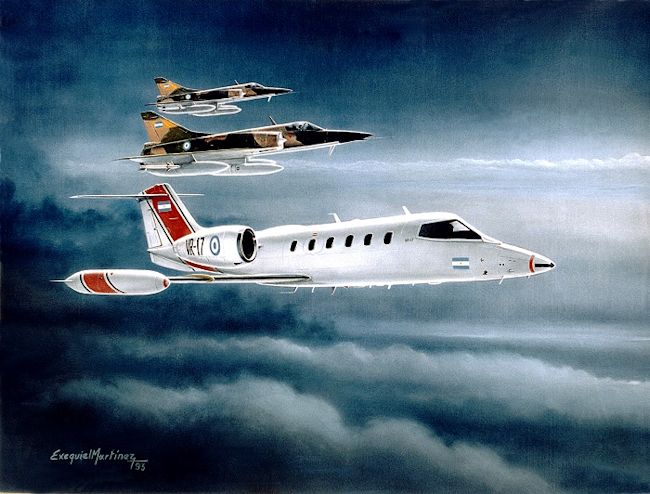 Cpl Mothe not only took his
section of Daggers 100 miles away from the target but also remained in the area
giving support and after the Daggers returned they also did so.
Cpl Mothe not only took his
section of Daggers 100 miles away from the target but also remained in the area
giving support and after the Daggers returned they also did so.
LR-36 (RANQUEL) was Tactic Air
Controller (OF 2207 with Capt. Williams, Lt Cercedo, 1st Cpl Rocha) during the
mission that sunk HMS Coventry. They flew over the islands and then returned to
their base (Comodoro Rivadavia). In total 22 missions to search for the enemy
were carried out on this day.
OF S/Nº: LR-35A LV-ONN.
Mission: transporting personnel militar.
Crew: captain Rafael
A. González Osterode, Lt. Enrique G. Felice and cabo principal Eduardo A. Lagger.
Left Comodoro Rivadavia at 23.25; landed at Río Gallegos at 24.
May 26th: on this day the Air Force
decided to bomb the British positions. As part of this mission two Daggers
bombed above the cloud cover. These Daggers (POKER) were protected by two Mirage
IIIEA (SOMBRA). Each one of these sections was supported by Fenix LR-35 (NONO)
with SOMBRA and HS-125 (RAYO) with POCKER. Bombs were dropped within the clouds
and following the directions of the radar in Puerto Argentino. Consequently
results were not observed.
Like on previous days Fenix also
undertook the search of the enemy with F-27, B-707, C-500, TS-60, LR-25 among
others.
OF S/Nº: LR-35A LV-ONN.
Mission: transporting personnel
militar. Crew: captain Rafael A. González Osterode and Lt. Enrique G. Felice y
cabo principal Eduardo A. Lagger. Left Comodoro Rivadavia at midnight, landed at
Río
Gallegos at 0.35 taking off at 0.45 and arriving to destination at
Río Grande at 1.15.
March 27th: MU 2/60 LV-ODZ guided
two Pucaras to the islands. Two missions with Learjets and several with other
airplanes from Fenix were flown to look for the enemy or retransmit
communications. HS-125 (RAYO) found some British CAPs but returned to base
without further incidents.
May 28th: Several missions to look
for targets were carried out by F-27 and Fenix planes. C-130s were also used to
look for the surface units of the enemy.
OF S/Nº: LR-35A LV-ONN.
Mission: patrol and reconnaissance
with radar. Crew: captain Rafael A. González Osterode, Lt. Enrique G. Felice
and cabo principal Eduardo A. Lagger. Left Río Grande at 9.05; landed at 11.10.
May 29th: Another section of Pucara
was guided by a Mitsubishi. Approximately 10 more missions were flown by Fenix.
May 30th: The Squadron flew a very
limited number of missions
May 31st: Missions picked up pace
for Fenix again with several TS-60, F-27 and Learjets looking for enemy targets.
These included
OF 2251: LR-35A LV-ONN, (TORO).
Mission: patrol and visual reconnaissance. Crew:
captains Clemente I. Velasco and Carlos A. Pane and 1st corporal o Juan M. Mothe.
Left Río Grande at 11.25; returned at 13.55.
June 1st: Hercules T-63 (TIZA) was
shot down by Cmdr. Ward when looking for enemy shipping with the loss of the
entire crew. LR-36 LV-LOG was sent to look for survivors to no avail though
theysaw a British CAP at 2,000 ft and therefore Vicecommodore De la Colina dove
to the surface of the ocean to escape from the Harriers. Notwithstanding what
had happened with TIZA Fenix flew approximately 10 missions (Lear, TS-60, F-27)
to look for the enemy.
OF 2152: LR-35A LV-ONN,
(NIDO).
Mission: patrol and visual reconnaissance. Crew: captains Clemente I. Velasco
and Carlos A. Pane, and 1st corporal o Juan M. Mothe. Left Río Grande at 10.30;
returned at 12.45.
June 2nd: Two missions with Learjets were flown to try to entice British CAPs when these planes “stooged” above the islands for roughly an hour. Even though a Hercules had been lost the previous day the Air Force sent another one in the same type of mission. Several F-27 and TS-60 missions were carried out in exploration mode.
June 3rd: Several search missions
flown with Learjets, TS-60 and F-27 by Fenix this day.
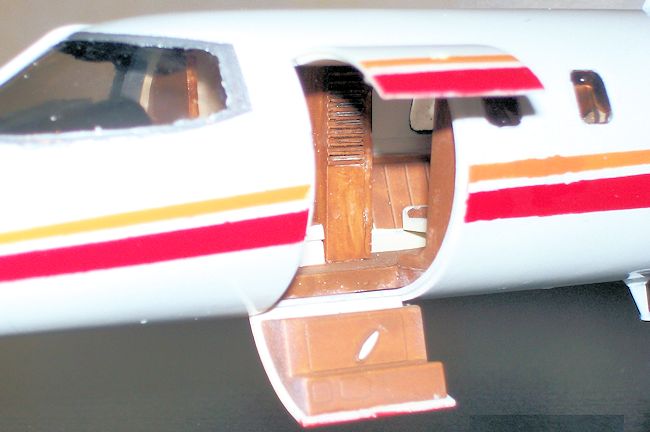 OF S/Nº: LR-35ª LV-ONN (PÚA). Mission:
patrol and visual reconnaissance. Crew: captains Carlos A. Pane and Clemente I.
Velasco, and 1st corporal o Juan M. Mothe. Left Río Grande at 11.25; returned at
13.10.
OF S/Nº: LR-35ª LV-ONN (PÚA). Mission:
patrol and visual reconnaissance. Crew: captains Carlos A. Pane and Clemente I.
Velasco, and 1st corporal o Juan M. Mothe. Left Río Grande at 11.25; returned at
13.10.
June 4th: A similar day as the 3rd
but without LV-ONN being involved.
June 5th: LR-35 T-21 was used to
look for enemy activity using thermic equipment (Vicecommodroe De la Colina, Mj
Falconier, NCO Mondolo, Cpt Lotufo, 1st Lt Bonaz. HS-125 flew a mission to
coordinate the attack of A4-B and M5 missions.
OF S/Nº: LR-35A LV-ONN.
Mission: transporting personnel
militar. Crew: captain Rafael A. González Osterode, Lt. Enrique G. Felice and
cabo principal Eduardo A. Lagger. Left Río Grande at 11.30, landed at Río
Gallegos at 12.10; took off at 12.55, landed at Comodoro Rivadavia at 14.10;
took off at 20.10, arrived in Río Gallegos at 21.15, left at 21.20, returned to
Río Grande at 21.55.
June 6th: Another mission with
LR-35 (T-23) was flown to divert British CAPs. Only 4 F-27 and a TS-60 missions
were flown in search of units of the Task Force.
OF S/Nº: LR-35A LV-ONN.
Mission: transporting personnel
militar. Crew: captain
Miguel A. Arques, Lt.
Enrique G. Felice and cabo principal Eduardo A. Lagger. Left Río Grande at
15.45; landed at Río Gallegos at 17.10.
June 7th: Black Day for Fenix.
OF2309 ordered two LR-35 to take pictures (recco) of the islands and distract
British resources. This section (NARDO) was made up of T-24 in the lead with
Vicecommodore De la Colina, Mr Falconier, Capt Lotufo (as photographer), NCO
Luna and NCO Marizza as photographer and LV-ONN as wingman (1st Lt Bianco, Lt
Casado, 1st Lt Bonaz, 1st Cpl Bornices. NARDO took off from Comodoro
Rivadavia at 8 am and at 40,000 ft they flew to the northwest of the islands
where at 9 am they contacted the Air Controller in Puerto Argentino (Stanley).
Due to lack of complete scope of the mission on the side of the CIC time was
lost until instructions were received that would allow them to guide the NARDOs.
This caused a delay to forward updated orders and NARDO1 started to turn left.
At that moment they were told to keep 90º heading and therefore they turned
right. This put them 20 miles away from their original position and at reach of
British air defenses. Upon asking about the position of British CAPs they were
informed that there were two (one 150 and the second one 190 miles away). At
that moment (9:12 am) Lt Casado in LV-ONN noticed two small explosions on the
surface of the sea at San Carlos and then 2 smoke trails coming up. He correctly
identified them as SA missiles. De la Colina also saw them and told the CIC that
he was returning to the continent while turning left. RAF Sgt. Cowburne was at
San Carlos airstrip that was servicing RAF GR3 Harriers from 1 (F) Sqn. There
was a red alert due to the imminent Argentine attack (it was in fact the
Learjets) and he saw HMS Exeter firing two missiles. One did not climb too much
before falling back to the ocean but the second one climbed steadily. The CIC
told De la Colina that there was no need to worry as the CAPs were far away but
De la Colina answered that it was “A ship we have seen on the surface”. Then he
told his wingman to keep calm. NARDO 2 was 3 meters behind to the right and 200
feet above NARDO1 climbing faster and turning tighter. At that moment one of the
Sea Darts fired by HMS Exeter hit NARDO1 close to the tail and the ball of fire
engulfed Learjet T-24. De la Colina said “We have been hit and there is nothing
we can do”. The plane was cut in half and the wings and nose section fell in a
flat spin. According to British sources they had been able to monitor the
communications and could hear the crew while the plane was coming down out of
control. Sgt Cowburne and his friends were able to see the plane and several
parts floating down on fire. There were no parachutes. T-24 with her crew
crashed in Borbon (Pebble) Is. NARDO2 further accelerated in a climbing turn and
returned to the continent. Fenix had lost it Squadron Leader and in this
incident the Air Force suffered the loss of the most senior officer (De la
Colina) during the war. Falconier had left the following letter to his kids in
case he did not return from the war, a letter that shows the Spirit of the
Argentines fighting for Malvinas:
"To Ñequi and Mononi (nickname of
two of his kids): your dad is not abandoning you, he is simply giving his life
for others, for you and your kids…and those who will inherit the Homeland.
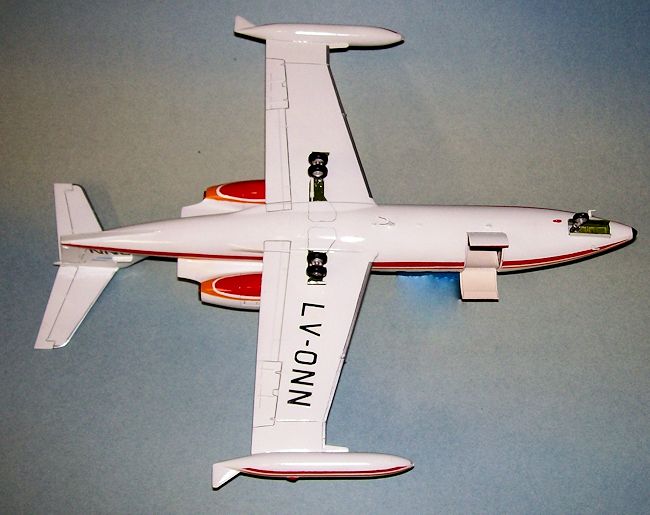 "You won’t have my presence and
advice but I leave you in company of the best and with the wisest advice: God.
Hold on to Him, feel that you love Him until your heart bursts with happiness
and love cleanly because it is the only way to live “the Good life”. Fight
temptation, don’t walk away from Him, and don’t give up. I will be with you,
side by side, holding to Love.
"You won’t have my presence and
advice but I leave you in company of the best and with the wisest advice: God.
Hold on to Him, feel that you love Him until your heart bursts with happiness
and love cleanly because it is the only way to live “the Good life”. Fight
temptation, don’t walk away from Him, and don’t give up. I will be with you,
side by side, holding to Love.
Be a “family”, respect and love Mom
even though you might find her imperfect; always be ONE, always together
I am leaving you my last name:
Falconier for you to use it proudly and dignify it, not with money or material
things, but with culture, with love, with beauty of clean souls, being more
human and less animal and above all facing life with Truth, being accountable
even if it “costs” you unhappiness or even your own life.
I am leaving you:
- Very little material things
- a last name “Falconier” and
- God (in front of Whom the rest
does not count)
Dad
PS: for my kids to read it when
they are young and until they are seniors because as time goes by even though
they will be more experienced or might have kids, they will find new and more
meaning to these words that I written with a father’s love.
NARDO 2. Crew: 1st Lt. Eduardo E.
Bianco, Lt. Eduardo E. Casado, photographer 1st
Lt. Miguel A.
Bonaz, mechanic Hugo Bornices. Took off at 8 am from Comodoro Rivadavia; flew to
51º 15´ S/63º 30´W Angels 400. LV-ONN landed back at
Comodoro Rivadavia at 10.40.
Section PILA (T-22 and T-23)
arrived in the area at the same time with the same mission, heard what happened
and returned to the continent. T-23 was sent again (alone this time) to search
for the enemy in the afternoon.
On this same day Fenix flew several
missions with F-27, TS-60 as in previous days.
June 8th: Fenix involvement in
Bluff Cove Disaster. When the British were found unloading troops in Bluff Cove
(Bahia Agradable) the Air Force sent several waves of attack planes that brought
havoc to the operation. Due to the limited avionics of the Daggers (mentioned
previously) Learjets were used as guide planes for PERRO and GATO sections that
attacked and impacted HMS Plymouth with 4 bombs leaving her out of service for
the remainder of the war. This was the last significant mission flown by Fenix.
Several F-27 and TS-60 missions in
search mode were carried out.
June 9th till June 14th
(ceasefire): More missions searching for the enemy were flown by F-27, TS-60 and
Learjets without incident.
June 10th:
OF S/Nº: LR-35A LV-ONN.
Mission: transporting personnel
militar. Crew: 1st Lt.
Eduardo E. Bianco, Lt. Enrique G. Felice and 1st corporal o Juan M. Mothe. Left
Comodoro Rivadavia at 21.15, landed at Río Gallegos at 22.25; took off at 22.35,
landed at Río Grande at 23.10.
June 12th:
LR-35 A LV-ONN.
Mission: transporting personnel militar.
Crew: captain Narciso
Juri, Lt. Luis A. Herrera and 1st corporal o Alejandro López. Left Río Grande at
16, landed en Río Gallegos at 16.35; took off at 16.55, arrived at Comodoro
Rivadavia at 18; left at 18.45, landed in Tandil at 20.35; left at 22.05, landed
in Comodoro Rivadavia at 24, left at 0.35 the following day and returned to Río
Grande at 2.05.
June 13th:
LR-35 A LV-ONN.
Mission: transporting personnel militar.
Crew: 1st Lt. Eduardo
E. Bianco, Lt. Enrique G. Felice and cabo principal Eduardo A. Lagger. Left Río
Grande at 15.30, landed en Río Gallegos at 16.05; took off at 16.20, arrived in
Comodoro Rivadavia at 17.25; left at 20.40, landed in Río Gallegos at 21.45;
took
off at 22, returned to Río Grande at 22.35.
We may conclude by saying that
Fenix Squadron fulfilled the expectations and contributed to the effort of the
Argentine Air Force by probing the British radar, distracting British CAPs,
helping to coordinate attacks (communications), guiding attack planes and
creating confusion among the British defences thus splitting the British them
and increasing the problems faced by Admiral Woodward (as he himself commented).
Additional notes about Fenix:
There was a group called “Los Diez
Mas Veloces” (The Fastest Ten) and it was formed by a HS-125 and nine Learjets
(2 x -24, 3 x -25, 3 x -35 and 12 x -36). These planes were as fast as most of
the combat planes and had very good navigational devices (VLF Omega) that
allowed them to safely fly over the ocean.
Enterprises that lent their planes
for Fenix include: YPF (HS-125), Loma Negra (LR-35), Dahm Automotores (LR-35
LV-ONN), Editorial Sarmiento (LR-25), Terrabusi SA (LR-25), Banco de Italia
(LR-25), Banco de Intercambio (LR-25), Bunge y Born (LR-35), Aeromaster (LR-25),
Orue SA (LR-24).
Besides the Learjets Cessna
Citations, Mitsubishi MU2/60, TurboCommander, Aerostar and Merlin III were used
and belonged to Direccion de Fabricaciones Militares, Automotores y Servicios,
Policia Federal, Masssalin y Celasco, Arbol Solo, Lineas Aereas Surenas, Vicente
Robles SA, Ventes SA, Banco interfinanzas, Astilleros Alianza, Coto SA, Gas del
Estado, Sidec SA, Angela Rosa, ENYS SA, Metalurgica Mellan, Colloco SA, Juan
Schanchemayr, Radio Cultural LS-5, Ynque SA, Barneco SA, Acindar SA.
LV-ONN – a brief history:
Learjet Inc 35A C/N 355 was built
in 1980 and is powered by a couple of Airesearch TFE731 SER. Airworthiness Test
on October 1st 1980. Purchased by Dahm Automotores in Argentina in 1980 and flew
as part of the Fenix Squadron in 1982. In October 1993 it was taken as N64RV by
RV Investments Inc, then was passed to Richard B. Levitz Sons Inc in August
1994, registered as N345 by Richard B. Levitz Sons Inc in May 1995, to
Gulfstream Aviation Enterprises in January 1997, to World Jet Inc in November
1997, to Gulfstream Aviation Enterprises Inc in May 1998, as N351WB to
Gulfstream Aviation Enterprises Inc in December of the same year, to World Jet
Inc in April 1999, to Plane I Leasing Company Inc in November 1999, to East
Coast Jets Inc on May 16 2001.
In the late 90s the plane was owned
by Rudi Dekkers who had a flight school in Venice. It is claimed that in that
Flight School some of the terrorists that hit the Twin Towers learnt to fly.
On July 25th 2000 US DEA agents
were present at OEA (Orlando Executive Airport) as they had they had been tipped
that a plane that was transporting drugs was going to land there. It was the
former LV-ONN and now N351WB. Two passengers left the plane and were intercepted
by the agents. They admitted having 5 kg of heroin in the plane. The pilot of
the plane was also detained. It was discovered that there were 8 more kilos
hidden in the plane and that this organization had smuggled heroin from
Venezuela to the US in numerous occasions. The plane was confiscated by the US
Government for drug smuggling, bought by East Coast Jets Inc thru the Insurance
Company and picked from DEA in Midland Odessa, Texas.
Currently the plane is part of East Coast Jets Inc. a Private Jet Charter and Aircraft Management based in Allentown, PA, has been modernized and has a new paint scheme.
| THE KIT |
This is the very old (80’s)
Hasegawa kit. All clear parts are “tinted” in light brown and other parts are
molded in white.
You basically get a very Spartan
interior with seats, raised panel lines, decals for a couple of different
options, a very simple landing gear and wheels bays with almost no detail to
speak of.
| CONSTRUCTION |
Having pondered the options of
which of all the Lear jets flown by Fenix I was going
to build based on color scheme, decals available, relevance during the war I
finally settled for LV-ONN. In this case the plane has one extra window on each
side so this one was the first thing to work on.
I made a template and transferred
it to the correct place at the end of the line of windows. Very carefully these
two new rectangles were opened and the corners rounded. As the side windows are
molded in one long strip I cut the last window on each clear part, removed the
thinner area between this window and the one ahead of it and used this plastic
to make the glass for the extra window. I carefully cut and trimmed the clear
tinted plastic and glued it in place. The internal walls were given a coat of a
mix of white and brown paint that delivered a light beige colour. This one was
painted over the clear strip of plastic in between windows and I was going to
build the plane with the door open and that area was going to be very visible.
The cushioned part of the walls in
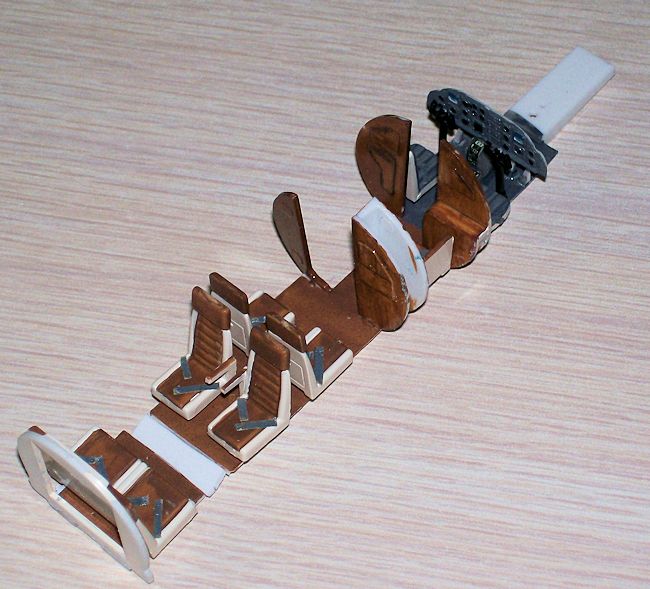 the passenger’s area was painted in brown and using pictures of this plane
posted in Internet as a reference the cockpit ones received a hand of light grey
paint
the passenger’s area was painted in brown and using pictures of this plane
posted in Internet as a reference the cockpit ones received a hand of light grey
paint
The passengers’ seats were painted
in the same beige colour (frame) and brown (cushions). Seat belts made with
masking tape were added. For the pilots’ the colours used were the same as the
side walls (grey) with more complex seat belts made with masking tape.
The floor where the seats are glued
in the kit has a rough surface that represents the carpet. But having decided
that I was going to make a plane with more windows now I found out that the
floor was too short and the last seats would be sitting BEFORE that last window.
So again, based on plans of the interior of the actual plane, I cut the last
portion of the floor, added an extension made with plasticard, painted it in the
colour of the carpet using an extra strip of plastic underneath as
reinforcement. With this modification now the last row of seats was sitting
after (behind) the last window.
All the wooden parts of the
interior of the plane (division, consoles and locker) were given a hand of light
brown and once dry a coat of brown varnish was applied with a brush. Before this
one was dry streaks to represent the ones in the wood were made by gently
running a piece of cotton over the varnish in a single direction.
The instruments panel was painted
according to pictures of this plane’s found in Internet, including the
artificial horizons with a light blue upper half and a white lower half. All the
dials were given a drop of Future to represent the glass. Pedals were painted in
silver and control columns in black.
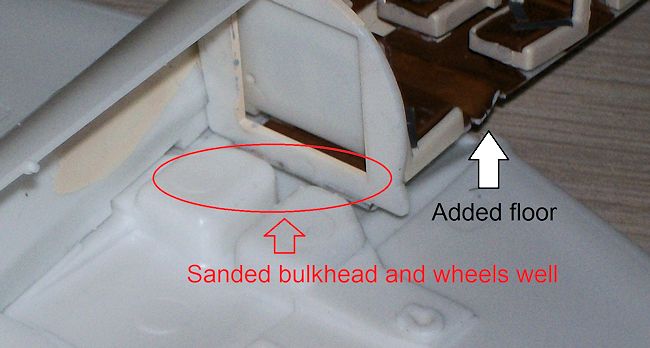 Once the seats and different
consoles in the cockpit were in place I started to dry fit the location within
the fuselage. Now that the rear bulkhead was sitting further back I had to trim
it to make it fit in the narrower area of the fuselage. I also discovered that
the now longer floor was not allowing me to glue the wings undersides because it
was in the way of the main wheels wells. To solve this new problem I sanded the
front part of the top of the wells and rounded a tiny bit the bottom part of the
bulkhead.
Once the seats and different
consoles in the cockpit were in place I started to dry fit the location within
the fuselage. Now that the rear bulkhead was sitting further back I had to trim
it to make it fit in the narrower area of the fuselage. I also discovered that
the now longer floor was not allowing me to glue the wings undersides because it
was in the way of the main wheels wells. To solve this new problem I sanded the
front part of the top of the wells and rounded a tiny bit the bottom part of the
bulkhead.
The steps located on the lower half
of the door were painted in brown and the internal frame in the light beige.
I glued 7.5 grams of lead over the
nose wheel well and painted in black the internal walls of the intake located at
the base of the vertical tail surface.
With all these modifications done I
was finally able to close the two fuselage halves and then glue the bottom part
of the wings.
After doing some sanding the
surface above the instrument panel shroud was painted in black.
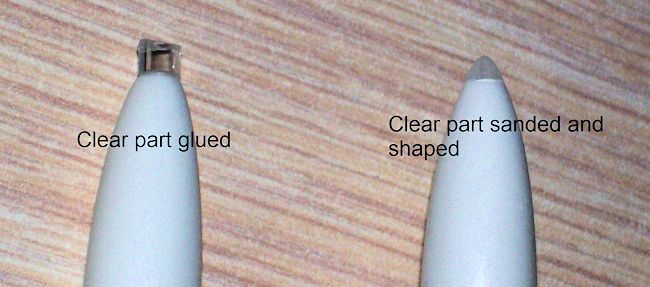 The wing tip tanks were glued and
as the nose was cut out as there are lights located there. I found some stubs of
clear plastic that matched the diameter of the base of the tip in the spares box
and glued them. After the glue was dry these cylindrical stubs were sanded to
shape them. Some little gaps left in the union were covered with white acrylic
base.
The wing tip tanks were glued and
as the nose was cut out as there are lights located there. I found some stubs of
clear plastic that matched the diameter of the base of the tip in the spares box
and glued them. After the glue was dry these cylindrical stubs were sanded to
shape them. Some little gaps left in the union were covered with white acrylic
base.
With both wing tip tanks thus
modified the top surfaces of the wings were glued to the bottom side ones. Fit
was perfect and no putty was required.
The horizontal tail surfaces were
glued with no fuss.
The engines nacelles interior and
blades were painted in aluminum. The exhaust area was brush painted with rust.
Everything was glued in place.
The windshield was attached with
little problem and all the clear parts and internal areas of the engine nacelles
were masked.
Some putty was required especially
along the fuselage behind the windshield and in the union of the underside of
the wings and fuselage. The landing gear (minus wheels) was glued.
The entire plane received a coat of dry grey to check for imperfections.
| COLORS & MARKINGS |
The entire plane got a coat of
gloss white. Now the most time consuming part started: painting the orange and
red strips.
I decided to take a more time
consuming but more efficient way to create them. I first cut long strips of
masking take to represent these lines. It was really challenging to calculate
the width of these at each point along the fuselage based on the couple of
(quite bad) pictures available of the plane in 1982. These lines continued under
the engine nacelles in oval concentric patterns. This was the most challenging
part as I had to cut ovals in the masking tape and center them under the
nacelles. More lines were added, this time, on the wing tip tanks.
This process took probably an
entire week. With the strips finished I then placed masking tape exactly
bordering the lines and the rest of the plane was also masked this way. Then I
peeled off the thin lines or
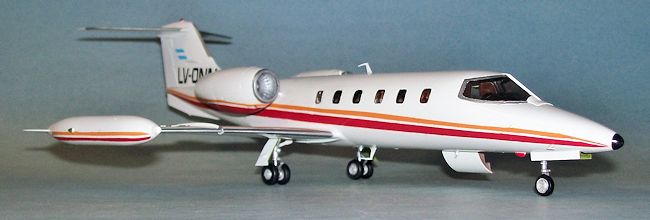 strips of masking tape and thus exposed the areas
where the orange and red colours were to be painted.
strips of masking tape and thus exposed the areas
where the orange and red colours were to be painted.
I mixed red and yellow until I got
an orange I was happy with and painted the top strips this colour. Once dry I
masked the orange areas and painted the lower strips in red.
The frame of the windshield and all
the borders of attack (wing, engine, tail) received a coat of silver. The nose
tip was painted in black.
Once all the masking tape was
removed the lines were almost neatly there…but in some areas the paint came off
along with the masking tape. So I had to mask again those areas and this time
with a brush I re painted them.
I have to admit that the lines are
far from perfect but it is the best I could do. I had toyed with the idea of
printing them in clear decal paper but the nacelles would have been an
insurmountable challenge.
The wheel wells and internal side
of the landing gear doors were painted with a brush with Interior Chrome yellow.
Navigation lights on top of the
tail, just behind the nose landing gear and left wing tank were painted in red.
The navigation light on the other tank was painted in green.
All the windows and lights received a coat of Future carefully applied with a brush.
I printed my own letters in clear
decal paper and protected the ink using Testors decal spray. The Argentinean
flag came from the spares box (I used a couple of large flags and cut them in an
angle). There were no more decals to be applied!
Once the decals were dry I used a
brush to cover them with a light coat of Future.
The only thing left to do was to
glue the main landing gear doors (the nose ones are molded with the fuselage
halves), the wheels, attach the two-part access door and scratchbuilt a couple
of antennas located above and below the fuselage.
| CONCLUSIONS |
The kit is very easy to build
unless you make some modifications like I did. Fit is almost perfect and level
of detail is very good.
Be this my tribute to the members
of the Squadron Fenix, especially Capt (Res)
Jorge Paez Allende and the crew of Vicecomodoro De la Colina.
With a BIG THANKS! to Exequiel
Martinez for allowing me to use his paintings to illustrate the article and give
it more “action”
| REFERENCES |
Escuadron Fenix by Jorge Munoz)
La Fuerza Aerea en Malvinas (I and
II) by the Direccion de Estudios Historicos
4 weeks in May by Capt. Hart-Dyke
(HMS Coventry)
http://historiasdeaviones.blogspot.ca/2012/07/el-escuadron-fenix-civiles-en-malvinas.html
http://loudandclearisnotenought.blogspot.ca/2011/01/lv-onn-learjet-35a-cn-35a-355.html
http://www.naplesnews.com/news/2011/aug/14/flight-school-instructor-911-rudi-dekkers-book-lee/
Charles Strong at East Coast Jets
Inc.
EC
Doug Dildy
June 2014
If you would like your product reviewed fairly and fairly quickly, please contact the editor or see other details in the Note to Contributors.